Hutchinson Composites
Roots in Tradition, Future in High Tech
by Mike Crowe
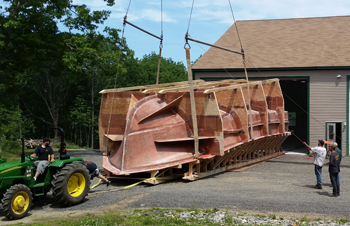
Mold over the plug being moved out of the shop. Hutchison Composites photo
More than two centuries before being nicknamed Vacationland Maine was all but officially the country’s boat building state. It still is. People from all over the U.S. and the world come to Maine to buy or have built a Maine vessel. Generations, in some cases of the same families, of Mainers have been engaged in the boat building industry.
While many more builders were required on a project in the days of wooden ships, the innovation that characterized the Maine industry then is very much a part of the industry today. From the futuristic high tech U.S. Naval vessels at Bath Iron Works, to the racing sail boats built at Lyman-Morse that nearly take flight, to the highly competitive business of building commercial fishing and pleasure vessels at boatyards all along the Maine coast, innovation remains the keyword.
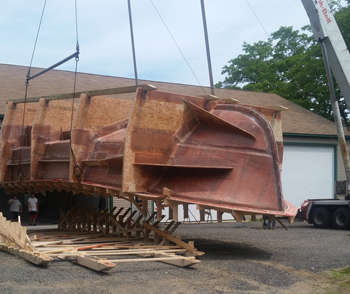
Plug framing base chain sawed off from upper plug framing. Hutchison Composites photo
At Hutchinson Composites in Cushing, Maine, Albert Hutchinson has hit his stride building primarily commercial fishing vessels. Hutchinson has embraced innovation and specialized by focusing on one of the two major parts of the modern fiberglass boat building process. He exclusively builds hulls and tops, kit boats, which are assembled and finished at boat building yards in Maine. Fiberglass boat building technology and materials engineering has continuously evolved since being introduced to commercial fishing boat building in Maine in the 1970s.
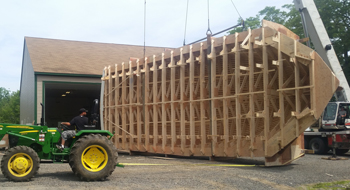
Rolling plug, interior facing tractor, and mold facing crane in background, right. Hutchison Composites photo
Hutchinson’s route to success in the industry is in many ways traditional. Aside from his description of his initial response to his first entry level job, it has the required elements of apprenticeships, aptitude and determination. Hutchinson said he couldn’t find a job in 1983 before he went to North End Composites in Rockland, Maine for any job they would offer. He said he hated that entry level job. But he learned to do some of the more skilled jobs there, got good at them and he said, “pushed on and made something out of it.” North End Composites was at the leading edge of innovative fiberglass technology at the time. The company was doing a lot of tooling, making the molds, used to form the fiberglass hull, for many of the boat yards building fiberglass boats.
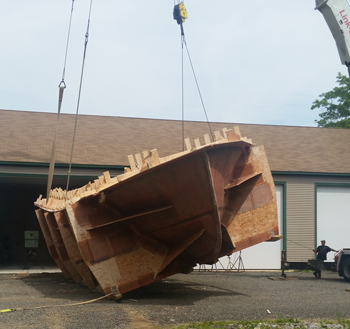
Mold being set down. Cables will pull the plug out of the mold. Hutchison Composites photo
In 1985 he took a job at Lyman-Morse in Thomaston, Maine. Lyman-Morse has built high end yachts since the 1920s, more than 200 of them. They know how to build boats. One of the boats he worked on was a 90' Hunt. Hutchinson said he learned how to do fiberglass at North End Composites a company at the top of it’s game and he learned how to build boats at Lyman-Morse, a leading Maine boat builder. He started his own business in the mid 1990s building boats that included Hood 26' power yachts, Wayne Beal 28s and 40s, and a dozen Lowell 43s. The Mussel Ridge is one of Hutchinson’s designs and he has built 21 Mussel Ridge 42s and 16 Mussel Ridge 46s. He currently has sixteen 46’ and nine 48’ boats on order.
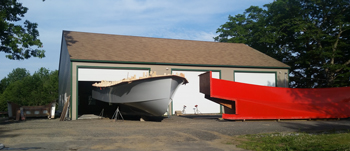
White plug coated for easily pulling it out of the mold. Half of the mold, right. Hutchison Composites photo
Recently, Tom Bernadi, who had worked for Lyman-Morse and is now out on his own, designed a new mold for Hutchinson. This process is a good example of integrating technology and innovation. Previously the wooden plug on which the fiberglass mold was built was done the same way plank on frame wooden boat molds were built for generations. Lines drawn on paper were transferred to the shop floor, often the second floor loft. The process is still called lofting the lines. Those lines were transferred to 1 inch thick boards that would be cut to form the cross sectional hull shape. Port and starboard sides together in some cases formed the so called wine glass shape. When all the molds were cut and set upright and vertical on the keel, long wood strips called ribbands were attached horizontally. For building a plug for a fiberglass mold, flexible plywood was bent over the ribbands, attached, faired, sealed and waxed. This was the plug over which fiberglass was laid to create a mold in which fiberglass hulls could be repeatedly made.
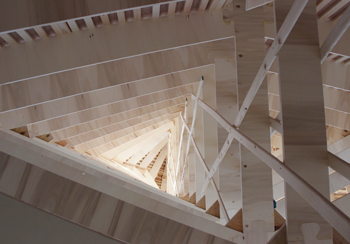
Precision interior geometry of the plug. Fanned out framing, upper left, under the ribbands, above foreground and center background, over which plywood is bent, dark, center background. Example of a puzzle cut lower right. Fishermen’s Voice photo
Bernadi however, loaded his loft drawings for the new plug into a computer, software sent the data to a C&C milling machine which cut and numbered all the parts formerly made with the more labor intensive and possibly less accurate hand lofting and carpentry process. The C&C process includes innovations such as puzzle cuts which fit two pieces together only as specifically designed. The parts are assembled with adhesives. Speed and accuracy are gained.
The wooden plug is covered with multiple layers of fiberglass cloth out to 1/2 inch thick. When it has cured the the plug and the mold on top of it are dragged out of the shop. Straps are run under the plug/mold combination and connected to a crane while the base of the plug is chain sawed off. The crane rolls the mold and plug combination over 180 degrees before lifting the plug out of the mold. The mold is pulled in halves which are rejoined to lay up a fiberglass hull. (See more photographs of plug/mold separation at Hutchinson Composites boatyard at fishermensvoice.com)
Hutchinson is currently finishing his first 48' kit boat. His five man shop completes a hull and top in five weeks.
